
How to create a perfect home theater in your living room
Step into stunning visuals and immersive sound with these top 3 TVs—discover which model transforms your space into the ultimate home theater experience.

Calibrating your TV for the best picture can completely transform your viewing experience. It’s more than adjusting brightness or contrast, it’s about unlocking the true color, sharpness, and clarity your screen can offer. But how do you get it just right? Learning the key TV calibration steps can make every scene pop and elevate your movie nights and gaming sessions like never before.
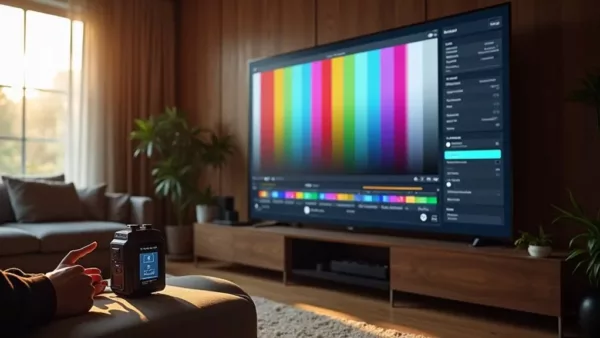
When you explore your TV’s picture settings, you’ll find options like brightness, contrast, color, sharpness, and tint.
Brightness controls the black levels, contrast adjusts the whites, color changes the saturation, sharpness improves edge clarity, and tint balances green and red hues.
Mastering your TV’s picture settings helps you achieve accurate and pleasing images, making your screen look fantastic every time.
When setting up your viewing environment, make sure the ambient lighting is dim but not completely dark to reduce eye strain and avoid reflections on your screen.
Position your TV carefully to prevent glare from windows or lamps, which can interfere with the calibration process.
Also, consider having neutral-colored walls in your viewing environment, as bright colors might affect how you perceive picture quality.
Adjusting brightness and contrast is key to getting the best picture quality on your TV.
Brightness controls the black levels, making sure dark scenes show all the details without losing shadows. Contrast adjusts the white intensity, helping to keep highlights clear and prevent the picture from looking washed out.
When you properly adjust brightness and contrast, you enhance the TV’s image depth and overall clarity. This simple calibration step can make your viewing experience much more realistic and enjoyable, especially with today’s advanced technology in TVs.
Setting the correct color temperature is key because it ensures that the colors on your screen look natural and consistent, avoiding those annoying overly warm or cool tones.
When you set the correct color temperature, it balances the red, green, and blue hues perfectly, making your viewing experience more realistic and comfortable for your eyes.
Most experts recommend a 6500K setting as the ideal color temperature since it closely matches daylight, giving you an accurate color reference for all kinds of content and viewing environments.
When it comes to fine-tuning sharpness and detail, finding the right balance is key. Adjusting sharpness too much can lead to unnatural halos around objects, making images look artificial.
On the other hand, too little sharpness results in a soft picture that lacks clear definition. By carefully fine-tuning sharpness and detail, you can improve edge clarity and texture without overdoing it.
This approach keeps images natural and enhances overall viewing quality, making your photos or videos look their best every time.
Calibrating color saturation and hue is key to getting the best picture quality on your TV screen.
When you adjust color saturation, you control how vivid or muted the colors appear, making sure they don’t look washed out or too bright. Changing the hue helps balance the colors so that skin tones and natural scenes look just right.
Proper calibration of color saturation and hue can really improve your viewing experience by delivering accurate and lifelike images.
Using test patterns and calibration tools is a smart way to improve your TV’s picture quality.
Test patterns help you check important settings like contrast, brightness, sharpness, and color accuracy, making it easier to fine-tune your TV.
Calibration tools, such as colorimeters, work alongside these test patterns to measure your screen’s output precisely.
Optimizing motion and response settings is key to enhancing your overall viewing experience. By adjusting motion smoothing, blur reduction, and response time, you can significantly reduce motion blur and judder during fast-paced scenes.
Properly optimized motion and response settings ensure smoother action without any unnatural effects, preserving picture clarity and maintaining the intended cinematic quality.
Whether you’re watching movies or playing video games, fine-tuning motion and response settings will make your screen come alive with sharp, fluid visuals for a truly immersive experience.
Once you have your ideal picture settings dialed in, saving your calibration settings is a smart move.
By saving your calibration settings, you can easily compare them whenever you tweak your TV or switch between different viewing modes. Most modern TVs come with user profiles or memory slots designed specifically for saving calibration settings, making it simple to keep track.
Comparing saved calibration settings helps you spot even subtle differences and ensures your picture quality stays consistent, especially after firmware updates or changes in your room’s lighting.
Keeping your calibration settings saved and ready to compare not only improves your viewing experience but also keeps your TV performing at its best.
Calibrating your TV for the best picture is key to enjoying your favorite shows and movies in stunning detail. To get the best picture, start by adjusting the brightness, contrast, color temperature, and sharpness in a controlled lighting environment. Using test patterns and calibration tools helps ensure your TV displays accurate colors and crisp details without artificial enhancements. Proper TV calibration also reduces glare and improves motion handling, giving you a smoother, more immersive viewing experience. By regularly calibrating your TV and saving your settings, you can maintain the best picture quality and make the most of your TV’s advanced technology.

Step into stunning visuals and immersive sound with these top 3 TVs—discover which model transforms your space into the ultimate home theater experience.
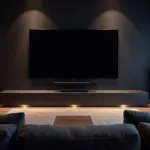
Discover three top TVs that dramatically elevate your home theater experience—delivering stunning visuals and features you won’t want to miss.

Start optimizing your TV’s sound with simple calibration tips that unlock richer audio—discover how to transform your listening experience today.
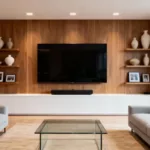
Merging affordability with impressive performance, these top 3 budget TVs defy expectations—discover which models deliver quality without breaking the bank.
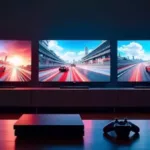
Get ready to discover the 3 best gaming TVs that deliver smooth, immersive gameplay with unbeatable performance and stunning visuals. Find out more inside!
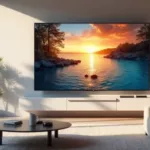
Leading-edge 8K TVs promise stunning visuals, but is the technology truly ready to transform your home entertainment experience? Discover the truth inside.